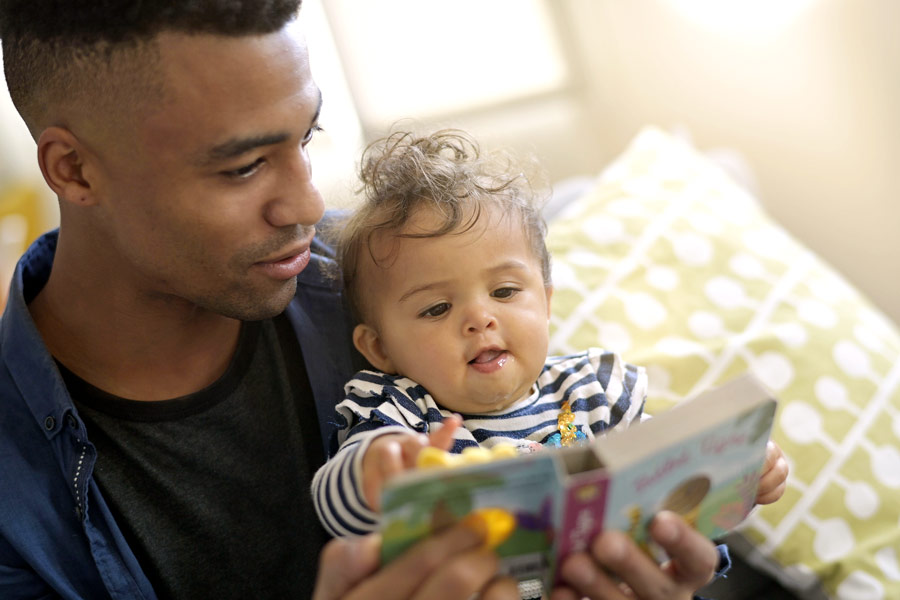Creative Ways to Involve Fathers & Partners in Childbirth Education Classes
Quote from Jessa VonFeldt on June 15, 2023, 9:58 amWritten by Debbie Young, MSL, ICCE, LCCE, CLC
Childbirth happens to the whole family. Creating space for dads in the classroom is important to make sure both parents are learning the same information and techniques to help in birth and beyond. I have been an educator for a long time, and I recall in the past that when some fathers were asked why they were attending the class would say, “Because she made me.” I also had more than a handful of dads who played with the coins in their pocket in the first session. Maybe they don’t do that anymore because they are more comfortable around the topic and feel more included (or maybe because no one uses coins anymore!). I’ve seen attitudes change with the times. I recently asked a dad for some feedback about why childbirth education is important to dads, and he said, “Walking into any birth uninformed is like coaching your kid’s little league games without any knowledge of how baseball is played.”
Still, some fathers today walk into the class with hesitancy and a few misconceptions due to Google searches. It can be apparent by the way they sit—sometimes closed-bodied, distracted, or with a “prove it to me stare.” They may be reluctant to answer the questions during the introduction part of the class. My goal is to make them feel welcome, so they can develop the skills that are essential for supporting their partner and baby.
Here are 9 ideas that may help you make the father successful in your classes.
- Welcome the couple and be sure to get dad’s name if it is not on your registration, as usually only mom registers for class. You can ask them to make a name placard for their desk or area they are sitting that has both names on it. If you intend to send any emails out after class, ask dad if he wants to have them sent to his email, too, and collect his address.
- When having class members introduce themselves, be sure to hear from both partners. Each week, ask another question about things like where they work, what state they were born in, number of siblings, etc. that both partners can answer. This helps bond the students in the class, including the dads. I heard the dads speaking after my last class, deciding where to meet up the week after the class ended. Remember that birth classes can be a support system for both parents!
- If you are brainstorming, split the couples with moms on one white board and dads on the other. Having dads work together also builds comradery and confidence in hearing how others are thinking.
- You can use demonstration to show massage techniques. The dad can replicate what you taught. You can walk around to check hand placement and verify that the mom likes the touch. Helping him know that “mom knows her body best” in most situations during labor can prevent him from being let down if she doesn’t like the massage he is using at different points in labor.
- Some educators use an Empathy Belly (or something similar) to help dads understand what it feels like to carry the extra weight during pregnancy and what she might really need help with, like tying her shoes.
- The couple can create a list of things they can do in early labor based on the time of day. Then, share the list with the class so everyone has good ideas. They can refer to it on the big day.
- Have individual couples create a list of relaxing words, wonderful trips they have taken, and/or words of encouragement that they might use during the birth on 3 x 5 cards for their birth bag. Working together like this is a great way to pull that team energy into the labor room.
- Make sure they each understand how to use the BRAIN acronym and in which circumstances dad might be the only one able to ask the questions (like transition). Encourage them to create their birth plan together, and each should understand why the points are important to them.
- A game like Fiction or Fact (or Myth Busting) can be fun, with each partner having a card that says true on one side and false on the other. You can read the list of common myths while everyone guesses if they are true or false. Let them know after they guess. No score is needed but it is a fun way for the couple to question and find the facts!
Other ways to engage male learners:
- Men tend to view learning in absolutes, so establish upfront the topics to be covered, timelines, and when the breaks are scheduled. This clear structure creates an easy-to-follow learning experience right from the start. They may appreciate a PowerPoint presentation to provide structure.
- Make the learning concepts relevant to their lives. You may want to create checklists and to-do’s for men to apply the information in a relatable, hands-on way.
- Use storytelling in your teaching. Stories are memorable and help men “see” themselves in a situation. Video clips also provide a storytelling element and help the men in class connect to the dads featured in the clips, which increases engagement and retention.
- Men process information better when it is experiential, so include hands-on elements in your class, such as practicing swaddling or changing diapers on a doll, as well as games.
- Remember to keep the mood light and don’t be afraid to use humor. Humor can relieve tension and reduce stress. Laughter also keeps the blood circulating, which can improve engagement in the classroom.
Dads are integral to the baby and family, so make sure they feel welcomed, supported, and educated during your class. They show up ready to learn, because they want to be a great support person for their partner and the best dad for their little one.
InJoy Related Products:
Understanding Fatherhood Curriculum – designed for fatherhood classes.
Debbie Young, MSL, ICCE, LCCE, CLC, ICBD, is the Customer Relations Manager at InJoy. Working with families as an educator and doula since 1987 and after using InJoy products in her work since 1994, Debbie joined the InJoy team in 2013. She continues to be involved with families as a doula and a childbirth educator on a part-time basis. She teaches, writes and speaks on various birth, postpartum and building family subjects. Debbie is a past president of DONA International and was the Managing Editor for the International Doula for eight years.
She has a BA in Health Promotion: Women’s Health and a Master’s in Leadership through Grand Canyon University. Debbie has interviewed many leading professionals in the Maternal/Child field.
Written by Debbie Young, MSL, ICCE, LCCE, CLC

Childbirth happens to the whole family. Creating space for dads in the classroom is important to make sure both parents are learning the same information and techniques to help in birth and beyond. I have been an educator for a long time, and I recall in the past that when some fathers were asked why they were attending the class would say, “Because she made me.” I also had more than a handful of dads who played with the coins in their pocket in the first session. Maybe they don’t do that anymore because they are more comfortable around the topic and feel more included (or maybe because no one uses coins anymore!). I’ve seen attitudes change with the times. I recently asked a dad for some feedback about why childbirth education is important to dads, and he said, “Walking into any birth uninformed is like coaching your kid’s little league games without any knowledge of how baseball is played.”
Still, some fathers today walk into the class with hesitancy and a few misconceptions due to Google searches. It can be apparent by the way they sit—sometimes closed-bodied, distracted, or with a “prove it to me stare.” They may be reluctant to answer the questions during the introduction part of the class. My goal is to make them feel welcome, so they can develop the skills that are essential for supporting their partner and baby.
Here are 9 ideas that may help you make the father successful in your classes.
- Welcome the couple and be sure to get dad’s name if it is not on your registration, as usually only mom registers for class. You can ask them to make a name placard for their desk or area they are sitting that has both names on it. If you intend to send any emails out after class, ask dad if he wants to have them sent to his email, too, and collect his address.
- When having class members introduce themselves, be sure to hear from both partners. Each week, ask another question about things like where they work, what state they were born in, number of siblings, etc. that both partners can answer. This helps bond the students in the class, including the dads. I heard the dads speaking after my last class, deciding where to meet up the week after the class ended. Remember that birth classes can be a support system for both parents!
- If you are brainstorming, split the couples with moms on one white board and dads on the other. Having dads work together also builds comradery and confidence in hearing how others are thinking.
- You can use demonstration to show massage techniques. The dad can replicate what you taught. You can walk around to check hand placement and verify that the mom likes the touch. Helping him know that “mom knows her body best” in most situations during labor can prevent him from being let down if she doesn’t like the massage he is using at different points in labor.
- Some educators use an Empathy Belly (or something similar) to help dads understand what it feels like to carry the extra weight during pregnancy and what she might really need help with, like tying her shoes.
- The couple can create a list of things they can do in early labor based on the time of day. Then, share the list with the class so everyone has good ideas. They can refer to it on the big day.
- Have individual couples create a list of relaxing words, wonderful trips they have taken, and/or words of encouragement that they might use during the birth on 3 x 5 cards for their birth bag. Working together like this is a great way to pull that team energy into the labor room.
- Make sure they each understand how to use the BRAIN acronym and in which circumstances dad might be the only one able to ask the questions (like transition). Encourage them to create their birth plan together, and each should understand why the points are important to them.
- A game like Fiction or Fact (or Myth Busting) can be fun, with each partner having a card that says true on one side and false on the other. You can read the list of common myths while everyone guesses if they are true or false. Let them know after they guess. No score is needed but it is a fun way for the couple to question and find the facts!
Other ways to engage male learners:
- Men tend to view learning in absolutes, so establish upfront the topics to be covered, timelines, and when the breaks are scheduled. This clear structure creates an easy-to-follow learning experience right from the start. They may appreciate a PowerPoint presentation to provide structure.
- Make the learning concepts relevant to their lives. You may want to create checklists and to-do’s for men to apply the information in a relatable, hands-on way.
- Use storytelling in your teaching. Stories are memorable and help men “see” themselves in a situation. Video clips also provide a storytelling element and help the men in class connect to the dads featured in the clips, which increases engagement and retention.
- Men process information better when it is experiential, so include hands-on elements in your class, such as practicing swaddling or changing diapers on a doll, as well as games.
- Remember to keep the mood light and don’t be afraid to use humor. Humor can relieve tension and reduce stress. Laughter also keeps the blood circulating, which can improve engagement in the classroom.

Dads are integral to the baby and family, so make sure they feel welcomed, supported, and educated during your class. They show up ready to learn, because they want to be a great support person for their partner and the best dad for their little one.
InJoy Related Products:
Understanding Fatherhood Curriculum – designed for fatherhood classes.
 Debbie Young, MSL, ICCE, LCCE, CLC, ICBD, is the Customer Relations Manager at InJoy. Working with families as an educator and doula since 1987 and after using InJoy products in her work since 1994, Debbie joined the InJoy team in 2013. She continues to be involved with families as a doula and a childbirth educator on a part-time basis. She teaches, writes and speaks on various birth, postpartum and building family subjects. Debbie is a past president of DONA International and was the Managing Editor for the International Doula for eight years.
Debbie Young, MSL, ICCE, LCCE, CLC, ICBD, is the Customer Relations Manager at InJoy. Working with families as an educator and doula since 1987 and after using InJoy products in her work since 1994, Debbie joined the InJoy team in 2013. She continues to be involved with families as a doula and a childbirth educator on a part-time basis. She teaches, writes and speaks on various birth, postpartum and building family subjects. Debbie is a past president of DONA International and was the Managing Editor for the International Doula for eight years.
She has a BA in Health Promotion: Women’s Health and a Master’s in Leadership through Grand Canyon University. Debbie has interviewed many leading professionals in the Maternal/Child field.











